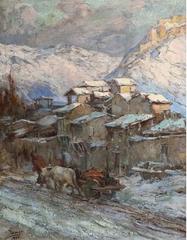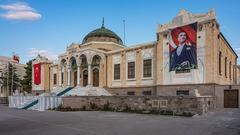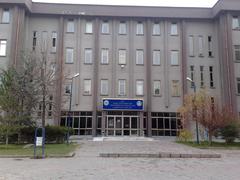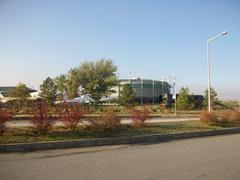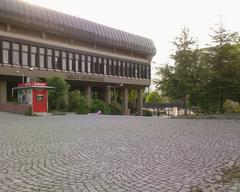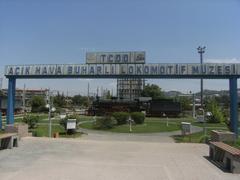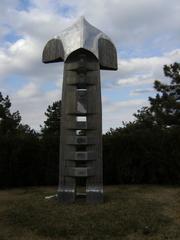
Roman Theatre of Ankara: Ultimate Guide to Visiting Hours, Tickets, and Historical Insights
Date: 04/07/2025
Introduction: Unveiling a Roman Legacy in Turkey’s Capital
Nestled amid the vibrant streets of Ankara’s Ulus district, the Roman Theatre of Ankara stands as a striking testament to the city’s deep-rooted history and cultural diversity. Dating primarily to the 2nd century CE, this ancient theatre reflects Roman architectural grandeur, engineering brilliance, and the enduring traditions of urban Anatolia. Today, the theatre is a living archaeological site, drawing visitors eager to explore Ankara’s Roman, Byzantine, and Ottoman heritage—making it one of the premier historical sites in the Turkish capital (Ankara University, 2021, Hurriyet Daily News).
This comprehensive guide details the Roman Theatre’s fascinating origins, key architectural features, and pivotal role in Ankara’s urban evolution. It also provides up-to-date information for visitors, covering opening hours, ticketing, accessibility, guided tours, travel tips, and nearby attractions. Whether you are a history enthusiast, architecture lover, or curious traveler, the Roman Theatre of Ankara offers a captivating journey into the heart of ancient Anatolia.
Historical Overview and Architectural Highlights
Roman Origins and Urban Significance
The Roman Theatre of Ankara was constructed during the city’s heyday as Ancyra, the capital of the Roman province of Galatia. Built into a natural hillside, the theatre not only optimizes acoustics and visibility but also exemplifies the Roman tradition of integrating monumental public spaces into the urban landscape. Its horseshoe-shaped cavea and arched entrances echo a blend of Roman engineering and Greek theatrical influences, evidencing centuries of cultural exchange (Ankara University, 2021).
The theatre likely accommodated around 5,000–7,000 spectators, serving as a central venue for drama, music, public ceremonies, and civic gatherings. The layout features a two-tiered cavea, a semi-circular orchestra, and a once-elaborate scaenae frons (stage building), elements characteristic of Roman theatres throughout Anatolia (Turkey Travel Planner).
Archaeological Discovery and Multi-Period Use
Rediscovered during construction work in 1982, extensive excavations have since revealed not only Roman foundations but also Ottoman-era additions, including a bathhouse and a tannery. These layers of occupation highlight Ankara’s transformation from a Roman provincial hub to a vibrant Ottoman city, with the theatre site reflecting centuries of adaptation and reuse (Hurriyet Daily News, Hurriyet Daily News).
Ongoing archaeological and conservation work—now part of the ambitious Archaeopark project—aims to protect and interpret both the ancient theatre and its later additions, ensuring the site remains an educational and accessible landmark.
Visiting the Roman Theatre of Ankara: Practical Information
Location and Access
The Roman Theatre is located between Hisar Street and Pınar Street, in the Ulus district, just below Ankara Castle and close to the Temple of Augustus (Wikipedia, Turkey Travel Planner). It is easily accessible from Ulus Metro Station, with clear walking routes connecting it to other key Ankara historical sites.
Opening Hours
- General Open-Air Access: The site is generally accessible during daylight hours, typically from 8:00 AM to sunset. However, access may be restricted during restoration work or special events.
- Official Guided Access: When Archaeopark facilities are fully operational, standard visiting hours are expected to be 9:00 AM to 7:00 PM (April–October) and 9:00 AM to 5:00 PM (November–March) (Turkey Travel Planner).
Tip: Always check with the Museum of Anatolian Civilizations or the Ankara Tourism Office before your visit for the latest updates.
Tickets and Fees
- Entry to the Theatre: Entrance is typically free as it is an open-air site. However, charges may apply for special exhibitions or guided tours.
- Museum Card (Müze Kart): For access to nearby museums and archaeological sites—like the Museum of Anatolian Civilizations and Roman Baths—a Museum Card offers great value (Türkiye Today).
Accessibility
While recent improvements have added pathways and ramps as part of the Archaeopark initiative, much of the terrain remains uneven and may be challenging for those with mobility issues. Contact the Museum of Anatolian Civilizations for specific accessibility arrangements.
Guided Tours and Cultural Events
- Guided Tours: Several local agencies and the Museum of Anatolian Civilizations offer walking tours of Ulus, including the theatre, Ankara Castle, and Roman Baths (Turkey Travel Planner).
- Events: Occasionally, the theatre hosts cultural performances, concerts, or educational programs, especially during heritage festivals. Check official websites or the Museum of Anatolian Civilizations for event dates.
Site Experience: What to See and Do
Key Features and Artifacts
- Cavea (Seating): Up to 22 reconstructed rows, originally seating thousands.
- Orchestra: Semi-circular area with traces of original pavement.
- Stage Foundations: Remnants of the scaenae frons and parodoi entrances.
- Ottoman Bathhouse and Tannery: Visible remains from later periods illustrate the site’s continuous use (Hurriyet Daily News).
Artifacts found during excavations—including statues, marble heads, and architectural fragments—are housed at the Museum of Anatolian Civilizations.
Interpretive Panels and Educational Value
On-site signage and nearby museum exhibits help visitors envision the original grandeur and understand the theatre’s socio-cultural role in Roman and later societies.
Atmosphere and Photography
The site’s picturesque setting below Ankara Castle makes it ideal for photos, especially in the soft light of early morning or late afternoon. The dramatic contrast between ancient ruins and the modern city skyline provides a memorable backdrop (Türkiye Today).
Itinerary Suggestions: Combine Your Visit
Enhance your visit by exploring other significant Ankara historical sites nearby:
- Ankara Castle: Offers panoramic views and centuries of history (Ankara Castle Guide).
- Temple of Augustus: Home to the Monumentum Ancyranum (Temple of Augustus Info).
- Roman Baths: An open-air display of Roman bathing culture (Turkey Travel Planner).
- Museum of Anatolian Civilizations: Exhibits theater artifacts and much more (Museum Info).
Visitor Tips and Safety
- Wear sturdy shoes for uneven surfaces.
- Carry water and sun protection during summer months.
- Visit early or late in the day for the best atmosphere and lighting.
- Respect the site: Stay on marked paths and do not climb on ruins.
- Check for conservation closures before your visit (tuerkei-antik.de).
Frequently Asked Questions (FAQ)
Q: What are the Roman Theatre of Ankara’s visiting hours?
A: Generally accessible during daylight hours; check official sources for current details.
Q: Is there an entrance fee?
A: Entry is typically free. Some nearby museums require a ticket or Museum Card.
Q: Are guided tours available?
A: Yes, through local agencies and the Museum of Anatolian Civilizations.
Q: Is the site accessible for people with disabilities?
A: Partial accessibility improvements have been made; some areas remain challenging.
Q: How do I get there?
A: Located near the Ulus Metro Station, within walking distance of major attractions.
Visuals and Interactive Resources
- High-quality images with alt text such as “Roman Theatre of Ankara cavea and orchestra,” “Ruins with Ankara Citadel backdrop,” and “Ottoman bathhouse remains.”
- Virtual tours and interactive maps are available via official tourism platforms and the Ankara Metropolitan Municipality.
Useful Links
- Ankara University: Roman Theatre of Ankara
- Official Ankara Tourism Website
- Museum of Anatolian Civilizations
- Turkey Travel Planner: Roman Theatre of Ankara
- Wikipedia: Antique Rome Theatre of Ankara
- Hurriyet Daily News: Roman Theater and Archaeology Park Project
- Hurriyet Daily News: Ottoman Bath Discovery
Summary and Final Visitor Tips
The Roman Theatre of Ankara is more than a relic; it’s a vibrant portal into the city’s layered history, from Roman grandeur to Ottoman innovation. Today, ongoing conservation and Archaeopark development are enhancing both the educational and experiential value of this unique site. Whether you seek archaeological intrigue or a scenic stroll through history, the Roman Theatre should be at the top of your Ankara itinerary.
For the latest updates on visiting hours, events, and tour options, download the Audiala app, explore interactive resources, and join the growing community celebrating Ankara’s cultural treasures. Experience the city’s ancient heartbeat for yourself—right at the Roman Theatre of Ankara.
References
- Ankara University, 2021, The Roman Theatre of Ankara
- Hurriyet Daily News, 2023, Roman Theater and Archaeology Park Project in Ankara
- Hurriyet Daily News, 2023, Ottoman Bath Discovered in Ancient Roman Theater
- Turkey Travel Planner, 2025, Roman Theatre of Ankara
- Wikipedia, 2025, Antique Rome Theatre of Ankara



